Chemical Methods for Brush Control
Chemical Methods for Brush Control thompsbbHistory
The era of using chemical methods for controlling roadside brush began in 1945 with the commercial availability of 2,4-D. These early days of roadside vegetation management consisted of blanket spraying of herbicides across vast swaths of roadside vegetation. However, because this method did not attempt to target only specific unwanted brush species, it also killed desirable vegetation. Without long-lived perennial vegetation competing with undesired vegetation, annual weeds and short-lived perennials grew and dominated roadside ditches. Additionally, early herbicides, such as Agent Orange, were also associated with increased risk for various types of cancer.
From the late 1980s until now, many Iowa counties have adopted IRVM principles to manage their roadsides. In the 2000s, cities also began to practice IRVM. Because the blanket spraying techniques described above were ineffective and potentially unsafe, IRVM emphasized strategic spraying to manage weeds and brush.
Timing of Strategic Herbicide Application
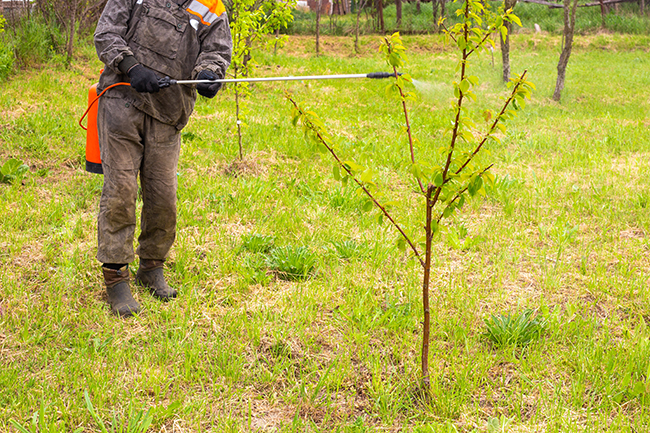
Some programs do not cut or mow in areas where herbicide is applied to allow time for the chemicals to completely kill the treated shrubs and trees. Regardless of the application method used, treating woody vegetation when it is young is more cost-effective and takes less time than using mechanical equipment to remove large trees and shrubs. Killing trees when they are young and small also prevents residents from becoming attached to the trees and objecting to their removal.
Worker Safety Around Chemicals
Though not part of a brush control strategy, pesticides are another chemical that may occasionally be used in some IRVM plans. Roadside managers should be aware of worker safety concerns related to herbicides and pesticides. Federal and state laws require that people using pesticides on public property, such as the right-of-way, be certified as pesticide applicators. For information on pesticide applicator certification, consult the Iowa Department of Agriculture and Land Stewardship.
Safety Tips When Applying Chemicals
- Always read the label; this is critical to ensure you use the product correctly and take appropriate precautions.
- Follow these personal protective equipment tips:
- Wear clothes such as a long-sleeved shirt, long pants, closed-toe and nonporous shoes, and chemical-resistant coveralls.
- Wear safety goggles or glasses to protect your eyes.
- Wear a cap or hard hat to protect your head.
- Wear heavy rubber (not cloth) chemical-resistant gloves.
- Tuck the gloves inside your shirt sleeves.
- If the label indicates they are safe to reuse, wash gloves with soap and water after every use.
- Disposable latex gloves can be used, but must be discarded after every use.
Sensitive Areas

Consider using non-chemical methods such as mowing, burning, and planting competitive native species to control woody vegetation in the following areas that are easily affected by chemical herbicides:
- row crops
- organic farms
- windbreaks
- bee habitat, including nearby flower sources
- flower and vegetable gardens
- landscape trees
- residences, especially those housing people with lung conditions such as asthma or COPD or habitants with pets
- prairie remnants and reconstructed prairies
- decorative flowers planted in the ditch by residents
- trails in the right-of-way
- waterways
If it is determined that herbicides must be used, communicate with landowners who may be affected and take extra care to avoid chemical drifting.
Pesticide applicators must follow what is known as Iowa’s “Bee Rule,” Iowa Administrative Code Chapter 45 21–45.31(206). Under this rule, commercial pesticide applicators cannot use pesticides labeled as toxic to bees for blooming crops within one mile of a registered apiary (a collection of beehives) between 8 a.m. and 6 p.m. Beekeepers can take legal action if they believe their site has been affected by pesticide spray.
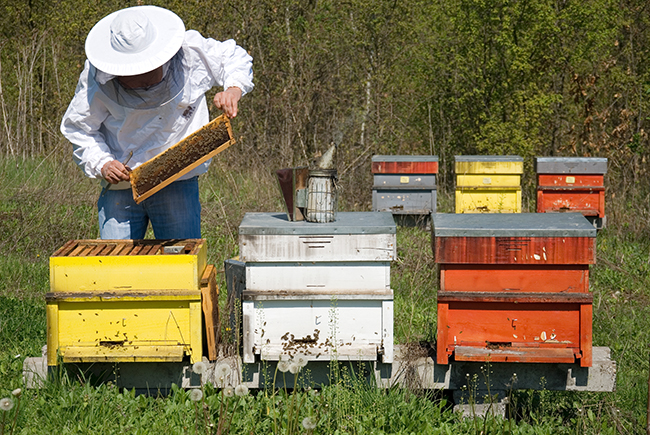
Pesticide applicators must also avoid spraying near organic farms, as drifting onto the farm could lead to decertification of the farm’s organic status. For the farm to be certified organic, it must be chemical-free for three years.
Pesticide applicators can identify sensitive areas, including organic farms and apiaries, by checking the Iowa DriftWatch map, which is available as a website and on the FieldCheck by FieldWatch mobile app. Applicators can register by email if they want to be notified when new sites are added near a given location.
Some counties have a no-spray program, where landowners adjacent to county roadsides may request that they not be sprayed. The landowner must agree to remove noxious weeds using non-chemical methods. Consult with the county engineer for details about local policies.
Foliar Spray Treatment
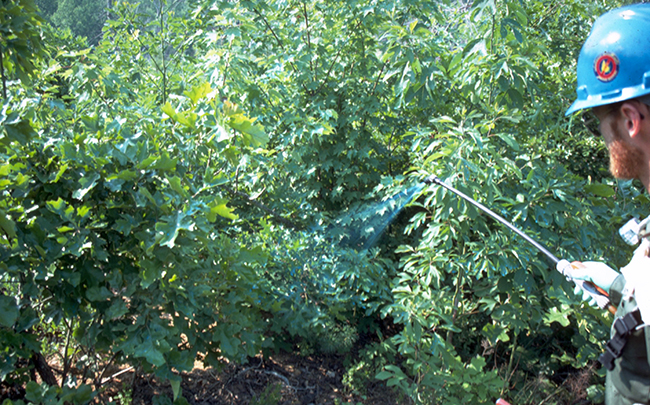
Foliar spray is used on growing plant leaves, stems, trees, and shrubs shorter than 10 feet tall and too numerous or small to cut efficiently. The herbicide absorbed through the leaves and stems moves through the plant, killing the growing parts and preventing regrowth. The lower canopies make it easier to completely cover the shrubs and trees with herbicide. However, it is not recommended for taller trees because it can be more difficult to obtain full coverage on them, and spray drift into nontarget areas is more likely.
Foliar spray is applied during the growing season from May to October to increase maximum absorption. Use extra caution to avoid spray drift onto private property or the vicinity of a waterway such as a creek, river, or drainage way. If spray drift is a concern in sensitive areas, consider using basal bark spray or cut stump treatment instead.
Low-Volume Foliar Spray
Applicators use handheld or backpack sprayers to treat tree foliage with a fine coating of herbicide. This method improves precision, saves money on chemicals, and reduces damage to nontarget vegetation. This method is more appropriate for smaller areas of vegetation than high-volume foliar spray.
High-Volume Foliar Spray
Applicators use mechanically powered equipment, such as truck-mounted sprayers with high-pressure nozzles, to treat the foliage of target shrubs and trees using 25–200 gallons or more of herbicide per acre. This method can be appropriate for large areas of dense vegetation.
Some more commonly used herbicides for foliar spray include triclopyr, triclopyr choline, metsulfuron-methyl, aminopyralid, and aminocyclopyrachlor. Before mixing herbicides, check the labels for proper instructions.
Frill Treatment
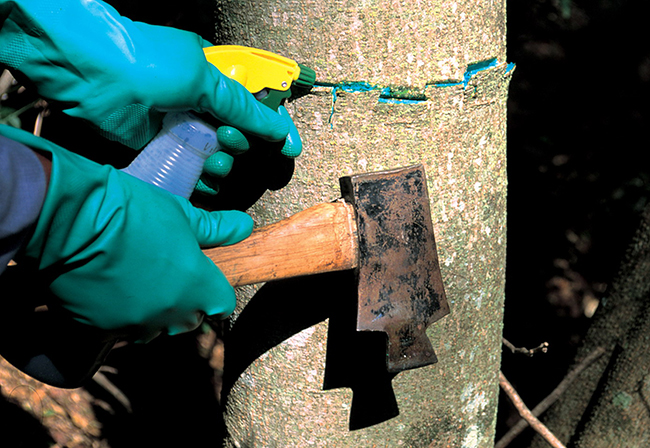
Also known as “hack-and-squirt,” this method of controlling invasive trees involves cutting the bark at least one inch deep to create frill cuts where herbicide can be applied to the cambium (the tissue layer that is the growing part of the trunk). Frill treatment is appropriate for large trees or trees at least one inch in diameter, where foliar spray is not feasible because of hard-to-reach brush and trees or nearby sensitive areas. The best time of year to use frill treatment depends on the herbicide; some can be applied at any time of the year, while others are applied only during periods of active growth. Spring, when sap flow is heavy, is typically avoided because the sap can reduce herbicide effectiveness.
To execute a frill treatment, cut the tree below the last live branch. Use a hatchet or other sharp blade to make downward cuts or frills at a 45-degree angle around the tree trunk to reach the cambium layer (the layer of cells that produces new wood and bark). Space the cuts evenly around the trunk, leaving spaces between them so the herbicide can move throughout the tree. For larger trees, a one-inch space between cuts is recommended.
The cuts should be immediately filled with herbicide from a spray bottle or backpack sprayer. The chemical is absorbed into the tree’s vascular system and transported throughout the tree, resulting in its death. Water-soluble herbicides like clopyralid, glyphosate, imazapyr, and triclopyr may be used. Read the label to ensure the product is approved for frill treatment.
Waiting at least a month after treatment before removing the tree ensures the herbicide reaches all parts of the tree and completely kills it. After the tree is dead, it can be felled using appropriate tree-felling techniques.
Basal Bark Spray Treatment
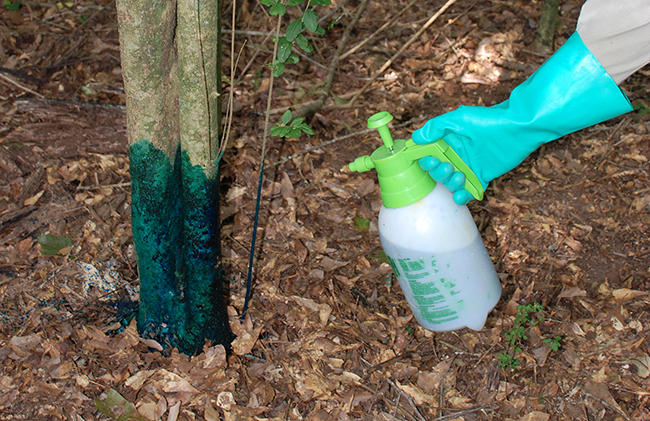
This efficient, targeted method involves spraying herbicide on live bark near the base of a plant. The bark does not need to be cut. An oil carrier in the herbicide solution facilitates penetration through the bark into the plant.
This method is more likely to be used within native plantings and areas that cannot be cut with equipment, such as brush in fencelines. Basal bark spraying is effective on shrubs and trees 2 inches or less in diameter at the base of the tree because the bark of these younger trees is thin enough for the herbicide to penetrate. The bark should be sprayed 12–18 inches above where the shrub or tree meets the ground. Using a dye to mark treated stems may assist in tracking which plants have been treated. A penetrating oil should be added if it is not included in the herbicide mix. Check the label for the recommended ratio of chemical to oil. Basal bark spray treatment is a slow process because trees must be treated carefully to avoid affecting nearby vegetation. It can take several weeks to see signs of herbicide impact. Depending on the species, it may take several months for the plant to completely die.
As with frill treatment, the best time of year for basal bark spray depends on the herbicide used. Some IRVM plans say the best treatment window is between November and March. If there is so much snow on the ground that you cannot reach the base of the tree, it is not a good time for basal bark treatment. Times of heavy sap flow should also be avoided. Spraying when the weather forecast calls for dry conditions for four days can prevent rain from washing the herbicide into adjacent vegetation, which could create a “ring of death” of dead vegetation around the base of the tree that has been sprayed.
The applicator uses a backpack or handheld sprayer to spray herbicide on the stems of target trees. The spray is applied around the entire circumference of the tree to the lower part of the trunk, 12–18 inches off the ground, where the bark is thinner. After the herbicide is absorbed, it moves throughout the plant and kills it.
Examples of herbicides used in basal bark spray include triclopyr, triclopyr + 2,4-D, aminopyralid, aminocyclopyrachlor, and imazapyr. Check the labels for proper instructions.
Cut Stump Treatment
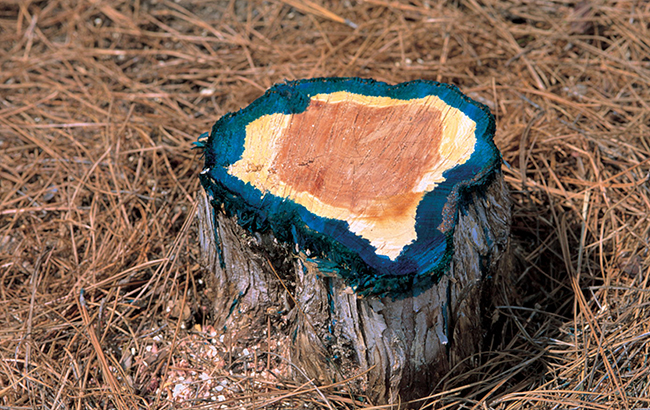
For this method, vegetation must first be cut at the stump to within 3–4 inches of the ground and then treated with herbicide, which enters the cambium and moves into the roots. Cut stump treatment quickly targets and kills the root systems of trees or shrubs. Stumps that are not treated with herbicide will typically resprout. Cut stump treatment is also used for woody vegetation that is larger than 6 inches in diameter is too large for basal bark spraying. Treatment can be done at any time of year when the sap is not flowing, but many roadside managers prefer October through early March for the best results.
Use a chainsaw or other equipment to cut the tree as level to the ground as possible so the stump will not affect any vehicles entering the area. Treat the exposed stump within a few minutes of cutting. Otherwise, the stump can seal itself off and prevent the herbicide from penetrating. Applying herbicide immediately also avoids missing stumps. Apply the herbicide directly to the lighter-colored greenish cambium tissue layer on the stump's outer edge.
Triclopyr and glyphosate products can be used in sensitive areas because they are relatively nontoxic to aquatic wildlife and leach slowly through the soil. Picloram, potassium salt of aminocyclopyrachlor, and aminopyralid can be used in other areas; they are not appropriate for sensitive areas because of their greater toxicity in aquatic environments and ability to stay in the soil for many months. Potassium salt of aminocyclopyrachlor and aminopyralid can effectively treat species that are tougher to kill. Use herbicides labeled as safe to use near waterways when treating brush adjacent to sensitive aquatic areas.